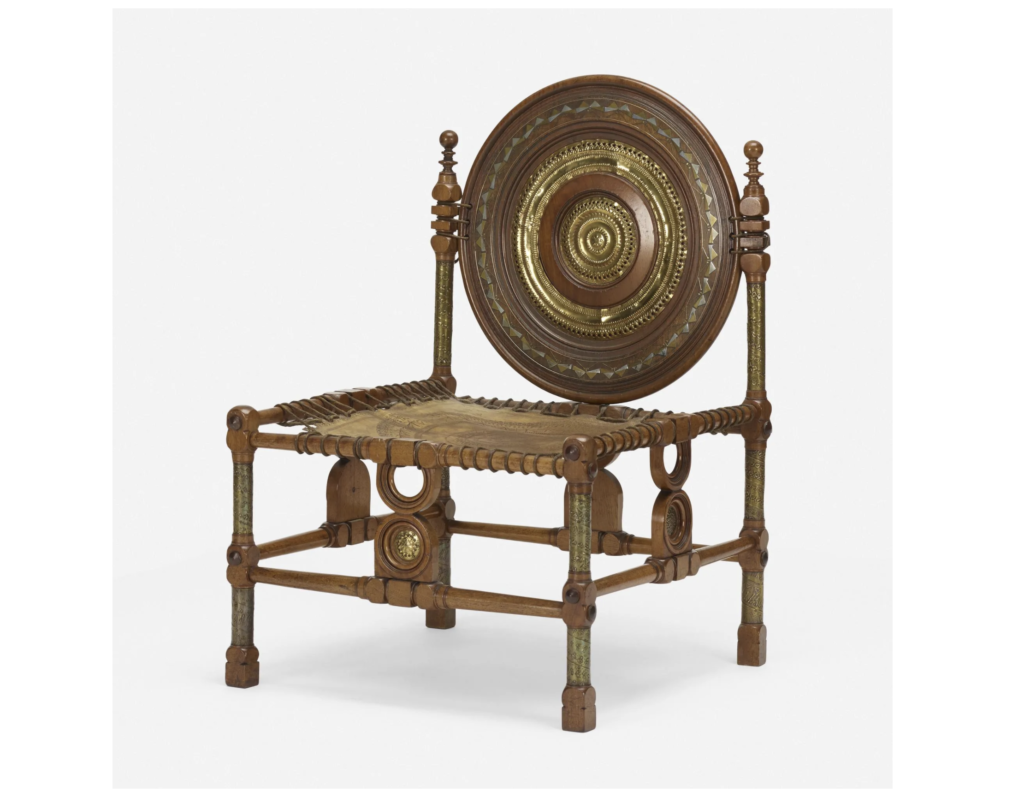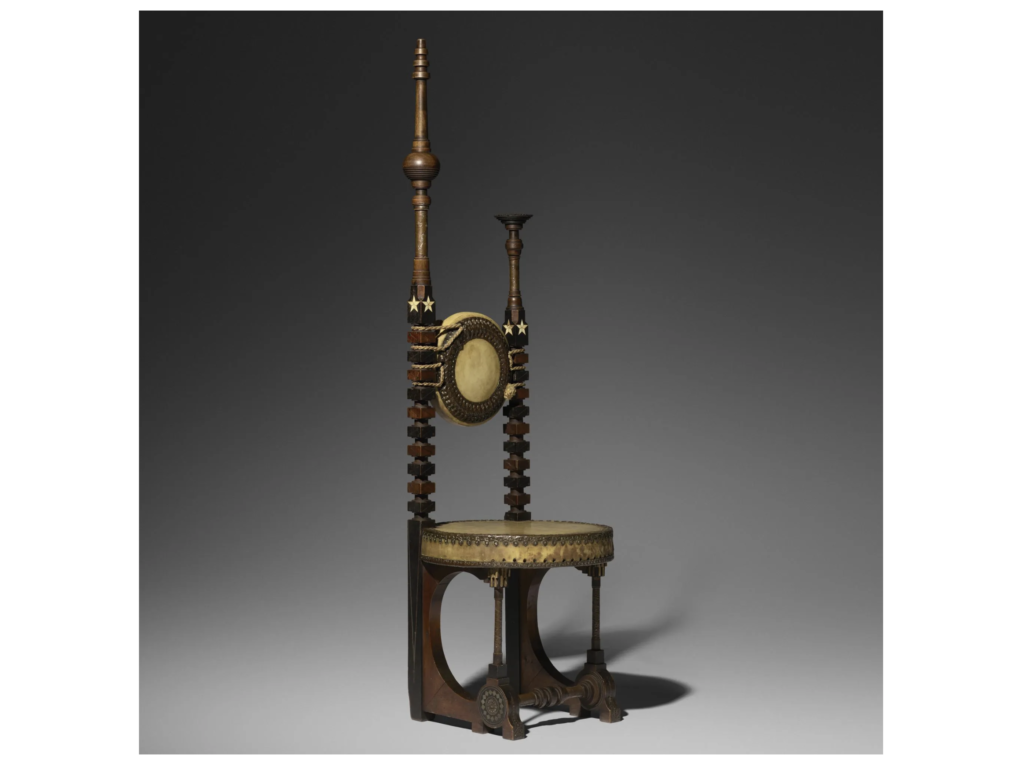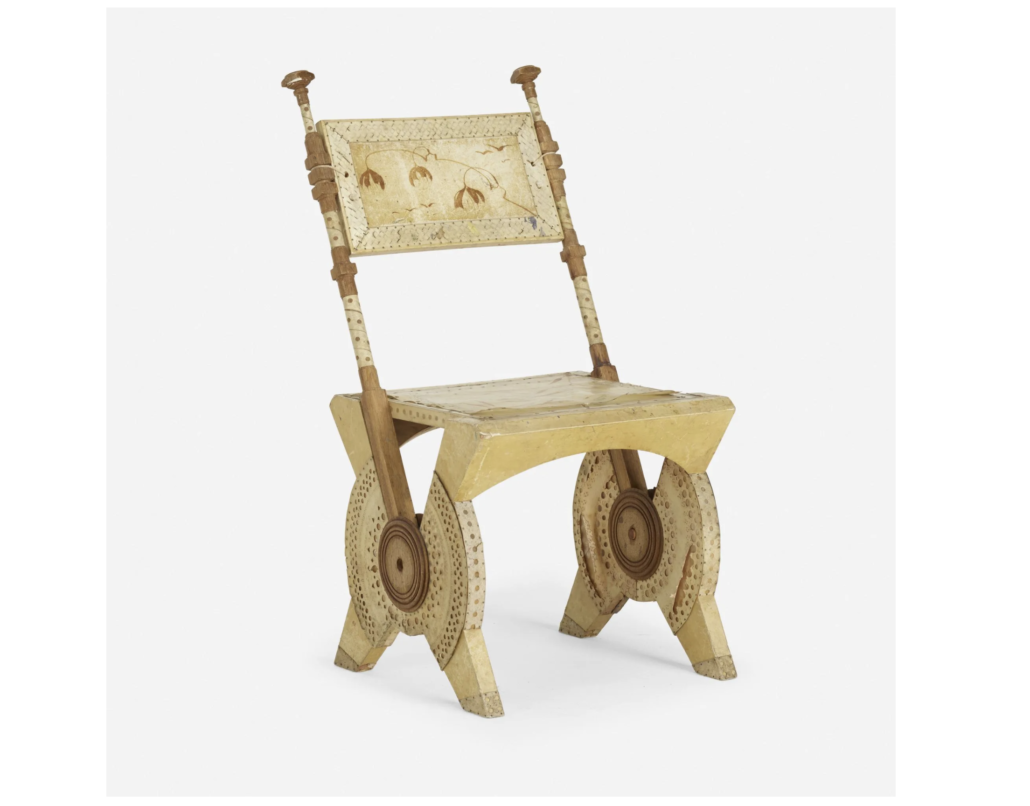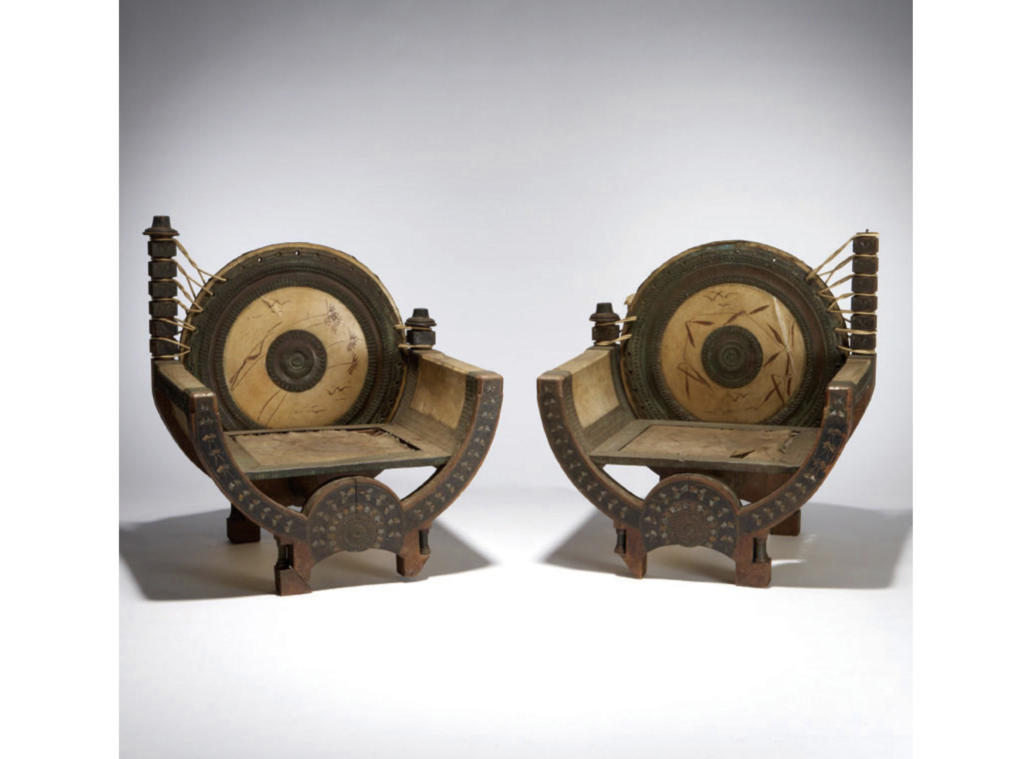
NEW YORK — Carlo Bugatti’s furniture shouldn’t work. The Italian artist-designer, who made his mark in the late 19th and early 20th centuries, created pieces that qualify as “fantastic” in both senses of the word — incredibly beautiful, and seemingly transported from a realm ruled by fantasy.
Carlo Bugatti furniture demands your attention and keeps it by presenting a visual feast as generous as an Italian grandmother’s holiday spread. He had a unique gift for combining and evoking a startlingly wide range of styles and eras, knowing instinctively how far he could go without going too far. A single chair could reflect Gothic, Asian and Moorish styles, as well as the more-is-more attitude to ornamentation that dominated the Victorian era; the naturalistic motifs of Art Nouveau; and touches that foreshadow Art Deco.

“As an artist and a designer, Bugatti is very unusual. He doesn’t fit into a movement, as it were,” says Megan Whippen, a senior specialist at Wright auction house in Chicago. Turning her focus to the furniture, she added, “There’s nothing minimal about it. It has an ornateness to it, and the dialog created in the material is beautiful. No detail goes unexpressed.”
Bugatti achieved his beguiling effects partly by selecting from a broad menu of materials. The same chair described above could draw its aesthetic power from the union of lacquered wood, vellum over wood, copper, walnut, bone, rope, and white metal inlay. Indeed, some time around 1902, Bugatti transformed that particular list of ingredients into an elegant, asymmetrical, markedly vertical chair that sold at Wright in October 2019 for a hammer price of $12,000 against an estimate of $7,000-$9,000.

What moved Carlo Bugatti to create such breathtaking and distinctive pieces of furniture? Unfortunately, we can’t be certain. His biography is frustratingly scanty. The best resource, a catalog compiled by the Musee d’Orsay in Paris for a 2001 exhibition of his work, appears to have been published only in French. What we do know reflects the personality of the sort of man who prizes dramatic flourishes more than accurate record-keeping. He is known to have designed some of his own clothes, which sources tend to describe as “eccentric.” The most famous anecdote involving Carlo Bugatti took place in 1902, against the backdrop of the Esposizione Internationale d’Arte Decorativa Moderna in Turin. The Queen of Italy, while visiting the fair, congratulated Bugatti on his “Mauresque” style of furniture. He reportedly replied, “You are mistaken, majesty, this style is mine!” Those who sass crowned heads generally aren’t the same people who get the vapors if a folder is misfiled.

But stating that Carlo Bugatti had no taste for accurate record-keeping might leave the wrong impression. It’s possible he didn’t keep records at all. If any production line documents, contracts, receipts, or similar material survives from the series of ateliers he operated in Milan and, later, Paris between the very late 1870s and 1909, the year before he declared himself retired, it seems that no English-speaking scholar has assessed and translated them. Very few Bugatti pieces have firm dates, and those that do earned them by appearing in period photos confirmed to have been taken at specific times. No one knows how many pieces of furniture Carlo Bugatti made, and almost no one will hazard so much as an extremely conservative guess. (Maybe there’s 1,000. Maybe.) It’s not even 100 percent clear if Bugatti sketched furniture designs and handed them off to others to fabricate or if he personally took a hammer, saw, or chisel in hand to physically bring a piece into being, or did both to some degree.

And though certain pieces might look delicate, even fragile, Carlo Bugatti built his furniture with purpose. Shannon Loughrey of Los Angeles Modern Auctions (LAMA) in Los Angeles confirms she is aware of people who actually use their Bugatti furnishings, and said, “The chairs function beautifully. The desks … things were different back then. There were no laptops. They’re very well made, pretty sturdy, but there are delicate features to them, little elements that would probably break off. But they’re so coveted, you just want to stare at them.” Whippen agrees. “The pieces were designed to be used, and when they are used, it only adds to them and makes them more beautiful.”

Carlo Bugatti’s life and work comes with another wrinkle that few other artists possess. At least two of his children are as successful, or more successful, than he: Rembrandt, a gifted sculptor of animals, and Ettore, the entrepreneur who created the famed Bugatti automobile. Both boys reportedly assisted Carlo in his workshop during the 1890s. Later, when they were grown men, Rembrandt sculpted a hood ornament for Ettore that took the form of a rearing elephant. Several museum exhibits have cheerfully juxtaposed Carlo’s chairs, Rembrandt’s animals, and Ettore’s machines, and the Mullin Automotive Museum in Oxnard, California, is home to abundant examples of work by all three men. Although there’s definitely a virtuous cycle going on that generates and sustains interest in the works of the Bugattis, Carlo would not fall into obscurity in its absence. “He stands on his own in his own right,” says Whippen. “If there was no Ettore or Rembrandt, I don’t think that changes the connoisseurship or skill [that went into his furniture]. That’s the genius behind him.”

All these factors combine to make Carlo Bugatti furniture sought-after at auction. In December 2009, LAMA sold a matched pair of his throne chairs for $13,475 against an estimate of $2,000-$3,000. “I wish I had that set back,” Loughrey said, laughing. “They’re incredibly rare. Now, they’re at least five times the value. I’d easily put a $50,000-$70,000 estimate on them.” She expects that a Bugatti pedestal LAMA offered in October 2016 and sold within its estimate for $12,500 would do much better now as well, probably selling in the $30,000-$40,000 range. “It comes off as a simple design, but it’s very complex with the craftsmanship and the materials used,” she said. “You could walk past it, but if you stopped to look at it, you would unravel its intricacy and materials. It’s surprising.”

A Carlo Bugatti pedestal realized $12,500 at Los Angeles Modern Auctions (LAMA) in October 2016. Courtesy of LAMA
Hudson Berry, director of modern design at Hindman, believes that the market for Carlo Bugatti furniture is bright. “I don’t feel there will be any decline in interest in the foreseeable future. Bugatti’s work still continues to amaze and fascinate,” he said. “Like designers such as Christopher Dresser and Charles Rennie Mackintosh, Bugatti had a voice all his own. While the references to past cross-cultural art and architecture histories are not in and of themselves radical, the combination and visual dialog they create still feels freshly progressive today.”

Loughrey says the market is accelerating, and likely to continue to do so, due to increasing scarcity. “Carlo Bugatti furniture is incredibly rare and people vie for it more and more,” she said. “It’s not like an Eames chair, where there are thousands of copies and you can wait for the perfect example. The values keep going up and up.”
Moreover, each piece of Carlo Bugatti furniture represents an audacious bet that paid off. Setting aside the issue of period-correct materials and manufacturing techniques, his furniture is nearly impossible to fake. Who else could envision and execute something that looks like this?
“When you see these pieces in person, and stand in front of them, you’re taken by the dialog of materials. He handcrafted those details, and they speak together,” Whippen says. “What could be incongruous makes a harmonious whole. Just the idea of it could be heavy-handed, but it’s done with such a delicacy and executed so beautifully, the craftsmanship is overlooked. The spectrum of material that he used is pretty incredible.”
# # #


